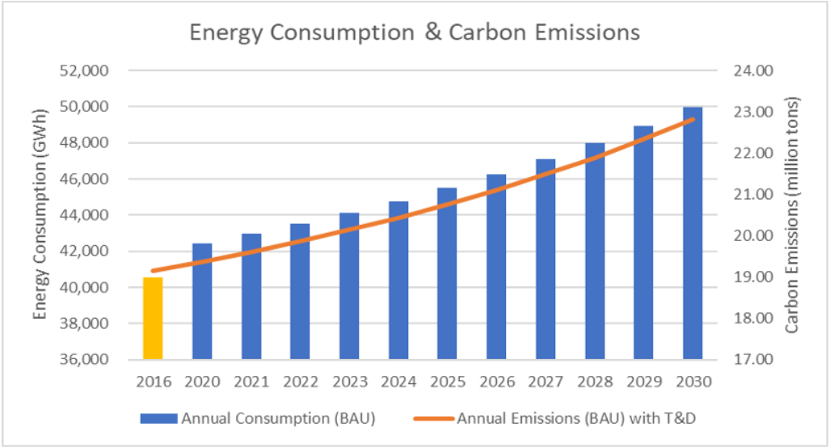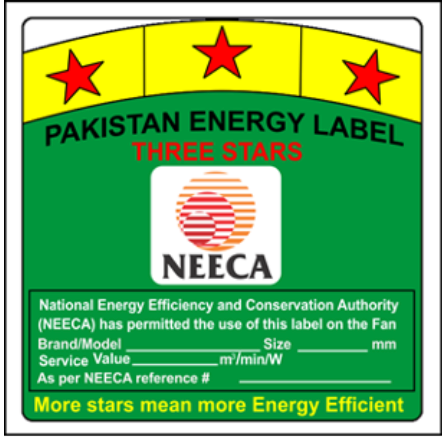
Empowering Efficiency: Lessons from Pakistan’s Energy Labeling Journey
Summary: Efficiency labels empower consumers to save costs and reduce potential greenhouse emissions. In 2016, SAMA^Verte and CLASP initiated a pioneering two-year project in Pakistan, introducing an energy efficiency label for ceiling fans to curb cooling sector emissions. However, despite a successful initiation, the label’s efficacy was hampered by a lack of leadership continuity for sustained implementation. Consequently, this case study offers valuable lessons for governments introducing energy labels for the first time.
Challenge: Globally, energy consumption for space cooling has surged, surpassing other building uses, and it more than tripled from 1990 to 2016.1 With over 230 million people and extreme heat (temperatures reached 49°C in 20222), Pakistan ranks fifth globally in cooling demand3 and is one of nine critical countries4 with the greatest number of people without adequate cooling. Most of Pakistan’s population rely on comfort fans as their first line of defense against the heat, with an estimated 143 million fans installed.
Since 2016, energy consumption from fans has followed the projected annual growth rate of 7.5%, with this compound growth expected to continue rising with the growing population and soaring temperatures. In 2022, fans in Pakistan consumed 44 TWh of energy and emitted 20 Mt of GHGs. Projections indicate that by 2030, cumulative energy consumption could reach 375 TWh, with CO2 emissions totaling 176 Mt under a business-as-usual scenario.
Figure 1: Annual Energy Consumption and Carbon Emissions from Fans in Pakistan5

Solution: In 2016, CLASP and local partner SAMA^Verte initiated a 3-star voluntary label6 for ceiling fans in homes and businesses. The label’s development included policy creation and program design. It aimed to provide technical specifications and energy performance grades to assist buyers, particularly government procurement agencies, in selecting efficient fans to cut long-term costs and lower cooling sector emissions. The label was introduced as voluntary due to initial skepticism in Pakistan’s cultural context and opposition to a mandatory scheme from manufacturers.
The labeling program is a nationwide initiative led by NEECA, with Punjab playing a key role. Punjab supported a launch campaign exceeding $1 million and continues to drive fan purchases through procurement programs. All Punjab activities are coordinated through the Punjab Energy Efficiency and Conservation Agency (PEECA), under the Provincial Energy Department.
Figure 2: Pakistan Three-Star Voluntary Fan Label

Developing the label involved engaging multiple stakeholders, including manufacturers (both bilaterally and through their association), the standards organization (PSQCA), and public testing labs such as the Pakistan Council of Scientific & Industrial Research (PCSIR).
Significant headway was achieved during the project, engaging 20-30 manufacturers to produce quality fans qualifying for the 3-star label. The program sold 700,000 efficient fans, with 95% through government procurement. It also prompted local electrical appliance manufacturers to recognize energy efficiency’s significance and the need for improvements.
Despite successes, progress post-program in 2017 was slow, with NEECA encountering challenges in asserting its influence. Nonetheless, In July 2023, mandatory Minimum Energy Performance Standards (MEPS) were officially enacted. However, compliance has not been established at this point. In tandem, two supplementary performance tiers were incorporated, thereby transforming the system into a comprehensive 5-tier star rating mechanism.
Impact
The energy efficiency label acted as the first step in achieving appliance efficiency in Pakistan and resulted in the following improvements:
Efficient ceiling fans led to estimated lifetime savings of $2,200 USD for small households and $6,600 USD for larger households and SMEs, which is significant in a country where the average monthly salary after tax is around $140 USD.
The market average efficiency of fans has improved, mainly owing to the advent of AC/DC hybrid fans and their growing popularity, especially in weak grid regions. These fans inherently consume less electricity than regular AC fans but work where AC fans cannot due to their hybrid nature. Additionally, there were also efficiency improvements in AC fan performance.
Initiation of bulk replacement programs: During the program’s second phase in 2017, a detailed plan was developed to replace 1.2 million fans in all educational and health institutions in Punjab. The plan was well received by the government, but implementation stalled due to lack of funding. The replacement program is finally going ahead with funding from the World Bank. A larger federal program is also being considered.
Initiation of retrofitting programs: A number of retrofitting programs kicked off towards the end of the project or soon after. These were run mostly by PEECA [Punjab Energy Efficiency & Conservation Agency]. Coupled with LED lights, retrofitting programs supported the replacement of 100,000 fans. Old fans were irreversibly disposed of to avoid entering back into circulation via the secondhand market.
Lessons Learned
Pakistan’s efficiency label experience underscores that technical aspects of programs are often simpler to handle whereas political and governance issues alongside budgetary constraints can often greatly impede the efficacy of government-led initiatives. These were the key lessons learned:
- Continuity and support from government leadership are critical to national labeling success: However, the label’s effectiveness was hindered by leadership instability, due to frequent shifts between ministries. As such it has not been able to present the case for energy efficiency at the highest levels within the government in a coherent and persuasive manner.
- Broad stakeholder engagement including engagement of industry in the labeling development process is key to adoption.
- Lack of promotional budgets: Once the label was launched, some of the large fan producers [the big 4, Tier 1 manufacturers with 48% market share at the time] came out with high-cost promotional campaigns to raise awareness of the availability of superior fans. However, these stopped quickly as the suppliers wanted stronger and bigger reciprocation from the government which could not allocate sustained funds for such campaigns. Consumer awareness was quickly lost.
- The direct impact of the label was limited due to its voluntary nature and lack of visibility to the consumer. It is advisable for appliance standards to be introduced as mandatory, to improve the likelihood of success.
- Strategic resource management: While implementation of the bulk procurement program has been delayed, the timely allocation of time and resources enabled a successful initial development of the program. This initiative serves as a model for similar schemes in the public domain at both federal and provincial levels.
0. IEA, “The Future of Cooling” (Paris, France: International Energy Agency), 11, accessed June 13, 2023, https://www.iea.org/reports/the-future-of-cooling.
1. Joe Goodman, “Climate Change Made India and Pakistan’s 2022 Early Heatwave ‘30 Times More Likely,’” Carbon Brief, May 23, 2022, https://www.carbonbrief.org/climate-change-made-india-and-pakistans-2022-early-heatwave-30-times-more-likely/.
2. CLASP, “Pakistan’s Cooling Needs Assessment Report,” 2022, 2.
3. Chilling Prospects: Tracking Sustainable Cooling for All (SEforAll) 2022
4. Pakistan Cooling Action Plan (2023)
5. The two-year project was funded by UK’s Foreign, Commonwealth, and Development Office (FCDO) and IFC.